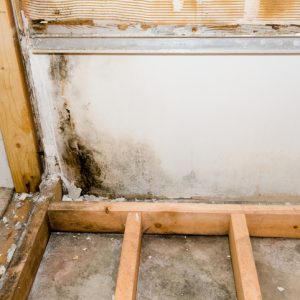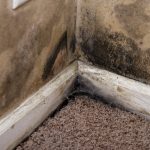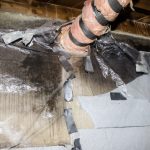The presence of basement mold can undermine the health and safety of your entire home. Your basement isn’t merely a storage space or an afterthought; it’s the very foundation upon which your home stands.
Similarly, just as we prioritize a robust foundation for our homes, it’s essential to ensure a mold-free and clean basement. By doing so, we’re not only upholding the structural integrity of the house but also safeguarding the health of everyone residing within its walls.
What Causes Basement Mold?
 Wet basements serve as the perfect breeding ground for mold. Firstly, moisture and dampness, moisture and dampness, when left unaddressed, provide the ideal environment for mold spores to multiply. Moreover, factors such as inadequate drainage and flooding play a significant role. Even a simple spill that isn’t cleaned up promptly can, surprisingly, contribute to elevated basement moisture levels.
Wet basements serve as the perfect breeding ground for mold. Firstly, moisture and dampness, moisture and dampness, when left unaddressed, provide the ideal environment for mold spores to multiply. Moreover, factors such as inadequate drainage and flooding play a significant role. Even a simple spill that isn’t cleaned up promptly can, surprisingly, contribute to elevated basement moisture levels.
Foundation Cracks
Cracks in the foundation aren’t just a threat to your home’s structural integrity; they also allow external moisture to seep in. Whether from rainwater or groundwater, these cracks can pave the way for mold to find its niche in your basement, thriving and spreading in the damp conditions they produce.
Ineffective Waterproofing
An improperly waterproofed basement can be as risky as having cracks in the foundation. Without effective waterproofing measures, your basement becomes vulnerable to external moisture, be it from rainfall, snowmelt, or high groundwater levels. Over time, this persistent dampness becomes a haven for mold growth, jeopardizing the basement’s health and cleanliness.
Health Impact of Basement Mold
When mold grows in the basement, it releases spores into the air that can easily circulate throughout the home. For many individuals, especially those with allergies or respiratory conditions, these spores can become irritants.
Inhalation often leads to sneezing, nasal congestion, itchy or watery eyes, and skin rashes. Additionally, those with asthma or other respiratory conditions might experience more frequent or severe attacks when exposed to mold spores.
Beyond the immediate allergic reactions, mold carries with it other health concerns. Prolonged exposure can lead to chronic respiratory conditions, headaches, and fatigue.
Certain mold strains can produce mycotoxins, which, when inhaled or come into contact with the skin, can cause more severe health issues. These mycotoxins have links to neurological problems and, in rare cases, can even be deadly.
Ensuring your basement remains mold-free isn’t just a matter of home maintenance; it’s a crucial step in safeguarding your family’s health.
Identifying Signs of Mold in Your Basement
Detecting mold early in your basement can save you from extensive damage and potential health hazards. While mold might sometimes be invisible to the naked eye, its presence often manifests through various signs.
Unpleasant Smells
One of the most telltale signs of mold growth is the presence of a musty or earthy odor. Even if you don’t see visible mold patches, that distinctive smell indicates its lurking presence. Mold thrives in damp, dark environments, and basements often provide the perfect habitat. If you catch a whiff of an unusual smell each time you enter your basement, it’s a strong sign that mold might be growing out of sight.
Wall and Floor Discoloration
Mold manifests visually in various ways, from black or green spots to fuzzy white patches or even orange films. Keep a keen eye on your basement walls and floors. Discoloration, especially around corners, ceiling tiles, and behind furniture or stored items, often indicates mold growth. Remember, mold might not always be in large, noticeable patches. Even small, sporadic growths can produce significant amounts of spores that harm your home’s air quality.
Health Symptoms Linked to Mold Exposure
Your body might be the first to alert you to a mold issue. If you or family members start experiencing allergic reactions such as sneezing, coughing, watery eyes, or skin rashes more frequently after spending time in the basement, mold could be the culprit. Chronic exposure can also lead to more severe health issues like persistent headaches or fatigue. Listening to these symptoms and taking them seriously can help you address a mold issue before it escalates.
Types of Basement Mold
Understanding the different types of mold in your basement is pivotal, not only for correct identification but also for formulating an effective remediation strategy. Each mold variety has its characteristics, growth conditions, and potential health implications. Familiarizing yourself with these types can help in quick detection and taking timely measures. Below are some of the most common types you might encounter:
- White Mold
This mold variety often appears on spoiling food, showcasing its white coloration. It’s also a usual suspect on water-compromised materials. - Green Mold
Much like white mold, green mold is another frequent offender on decaying food. Its spores can become airborne, dispersing throughout your home and potentially triggering allergies or asthma episodes. - Black Mold
Arguably the most notorious, black mold is a frequent unwelcome guest in basements. As it multiplies, it can occasionally emit toxic mycotoxins, heightening some health concerns when consumed. You’re likely to spot this mold type on basement walls, carpets, and wooden structures.
Mold’s Impact on Various Materials
Understanding the specific materials that make up your basement and their susceptibility to mold is key to both its prevention and effective treatment. Different materials have varying degrees of vulnerability to mold, depending on their composition and the conditions they’re exposed to.
 Drywall
Drywall
Constructed with wood and fiber particles, drywall offers an inviting environment for mold to flourish. At Crackmasters, our experts can inspect behind your drywall by drilling a small hole and using specialized tools. If mold lurks there, replacing affected sections may become necessary.- Wood
Your basement likely hosts a range of wooden elements, from structural beams to stored belongings. Given the organic nature of wood, it presents an attractive substrate for mold colonization, potentially undermining the structure over time. To tackle this, relocate any damp wooden items to a drier, well-ventilated spot and encase them in plastic to prevent mold migration. - Fabrics
Porous by nature, fabrics in basements—whether on furniture or stored belongings—are susceptible to mold infestations similar to wood. For mitigation, seal affected fabric items in plastic and air them out in a dry, well-ventilated area. Items like towels can be machine washed and dried to curb mold proliferation. - Carpeting
Carpeting in basements is a risky choice due to its porous texture, making it a mold magnet, especially if exposed to moisture from foundation cracks or flooding. In many cases, professional cleaning may help, but replacing contaminated carpeting might be more prudent.  HVAC Systems
HVAC Systems
When an HVAC duct courses through your basement, ensure you inspect and clean its drip pan frequently. The combination of condensation and limited airflow can transform an HVAC system into a mold hotspot.- Drains, Pipes, and Faucets
Given that most of a home’s plumbing infrastructure often resides in the basement, vigilance is key. Watch out for leaks or drips in these areas, as they could inadvertently cultivate an ideal mold habitat.
How Basement Waterproofing Prevents Mold Growth
Basement waterproofing acts as the first line of defense against unwanted moisture, ensuring that your basement remains dry and less susceptible to mold growth. A dry basement reduces the likelihood of mold spores finding the damp conditions they crave.
A waterproofed basement enhances the structural integrity of your home, minimizes potential damage from flooding, and offers peace of mind, knowing your living space remains protected.
Mold requires moisture to grow. By implementing effective waterproofing techniques, you limit the amount of moisture that enters your basement. This direct relationship means that a well-waterproofed basement creates an environment hostile to mold growth.
Whether it’s sealing foundation cracks or using moisture barriers, these measures ensure that your basement remains inhospitable to mold, safeguarding both your home and your health.
Tactics to Tackle and Ward Off Basement Mold
- Spotting and Fixing Cracks Promptly
Cracks in your basement walls or floor can act as entry points for water. By identifying and sealing these cracks in a timely manner, you prevent water from seeping in and creating a damp environment conducive to mold growth. Regularly inspecting your basement for any signs of damage and addressing them promptly is crucial. - Implementing Proven Basement Waterproofing Strategies
Several waterproofing methods, from sump pumps to interior drainage systems, can keep basements dry. It’s essential to assess your home’s specific needs and apply the most effective solutions. Whether it’s applying waterproofing membranes or installing drainage tiles, each strategy plays a role in ensuring your basement remains dry and mold-free. - Regularly Performing Maintenance Checks and Assessments
Routine checks of your basement can spot potential issues before they escalate. Check for damp spots, signs of water damage, and malfunctioning equipment. Additionally, regular assessments of your waterproofing system’s efficacy ensure that it’s functioning optimally, further reducing the risk of mold growth. Such preventive measures help in maintaining a healthy basement environment in the long run.
What are Drainage Tiles and How Do They Function?
Drainage tiles, commonly referred to as weeping tiles, play a pivotal role in maintaining a dry basement environment, which is crucial for preventing mold growth. These tiles are essentially perforated pipes installed around a home’s foundation, either externally or beneath the basement floor. Their primary function is to collect and redirect excess water away from the foundation. This process is vital in areas prone to heavy rainfall or high groundwater levels.
The way drainage tiles work is simple yet effective. They sit at the base of the foundation, where they intercept water that accumulates in the soil. This water, which would otherwise exert hydrostatic pressure against the foundation and potentially seep into the basement, is collected by the drainage tiles. The water then flows through these perforated pipes, which are sloped away from the house, effectively diverting it to a safer discharge area, like a storm drain or a sump pump.
Functionality
- Drainage tiles are perforated pipes installed around the foundation of a home.
- They collect excess water from the soil and channel it away from the foundation, reducing hydrostatic pressure.
- This process prevents water from seeping into the basement, maintaining a dry environment unsuitable for mold growth.
Installation
- Typically, drainage tiles are installed at the footing level of the foundation during construction.
- For existing homes, they can be retrofitted externally around the foundation or internally beneath the basement floor.
Maintenance
- Regular checks are necessary to ensure drainage tiles are free from blockages.
- Over time, they can become clogged with soil or roots, which diminishes their effectiveness.
Drainage tiles play a crucial role in basement waterproofing. By effectively managing groundwater, they protect basements from moisture accumulation, thus preventing conditions conducive to mold growth.
Maintaining a Mold-Free Basement
The benefits of a mold-free basement extend beyond structural well-being; they encompass health, home value, and peace of mind. A basement devoid of mold is a testament to proactive home maintenance and foresight. By upholding certain practices, homeowners can not only tackle existing mold but prevent future outbreaks.
Ventilate Your Basement Adequately
A well-ventilated basement is more than just a luxury; it’s a necessity for maintaining a mold-free environment. Moisture thrives in stagnant, closed-off spaces, making your basement a prime target for mold infestations. By promoting consistent airflow, you can effectively curb the moisture that mold thrives on.
- Regular Airing Out
Make it a habit to periodically open basement windows, especially during dry days. This simple act can significantly reduce humidity levels. - Invest in Exhaust Fans or Vents
Installing exhaust fans or vents, especially in areas like basement bathrooms or laundry rooms, can be invaluable. They actively pull damp air out, replacing it with drier air from outside. - Consider Cross-Ventilation
If your basement design allows, create openings on opposite walls to encourage a natural flow of air. Cross-ventilation can be highly effective in reducing stale, damp air.
Deploy Dehumidifiers in High-Humidity Seasons
While ventilation helps in reducing humidity, sometimes, especially during the peak of summer, you need a more robust solution.
- Choose the Right Capacity
Ensure you select a dehumidifier that matches the size and moisture levels of your basement. An underpowered unit won’t be effective, while an oversized one might consume more energy than necessary. - Regular Maintenance
To get the best out of your dehumidifier, regularly clean its filters and coils and empty its water collection tray. This not only ensures efficient operation but also prolongs the device’s lifespan. - Monitor Humidity Levels
Consider using a hygrometer to keep track of your basement’s humidity. Aim to maintain levels below 60% for a mold-resistant environment.
Maintaining a Mold-Free Basement Through Gutter Care
While gutters might initially seem unrelated to your basement’s health, they silently play a pivotal role in mold prevention. Here’s how you can leverage them effectively:
- Stay Vigilant After Storms
Firstly, after a heavy downpour or storm, it’s wise to inspect your gutters for any blockages. Elements like leaves, twigs, and other debris can swiftly gather, leading to obstructions. - Commit to Routine
Additionally, at least twice a year, particularly in spring and fall, it’s beneficial to give your gutters a thorough cleaning. Adopting this routine can shield you from potential costly repairs down the line. - Direct Downspouts Effectively
Lastly, ensure that your downspouts channel water a minimum of six feet away from your home’s foundation. If they fall short, consider adding extensions to redirect the water further away.
Actively combatting basement mold is paramount not just for the structural health of your home, but, more crucially, for the well-being of those who live within its walls. A mold-free basement translates to cleaner air, a healthier living ambiance, and an overall peace of mind. So, take charge, heed these expert suggestions, and relish the advantages of a secure and dry basement.
If you notice ANY mold in your basement, contact Crackmasters immediately, and we will get clean it up immediately and prevent any health risks for you and your family members. To avoid basement mold, we offer basement waterproofing in Mississauga, Oakville, Brampton, Etobicoke, Burlington, Acton, Milton and Georgetown. However, if it’s too late and mold has formed in your basement, we will repair it promptly, professionally and economically. Contact us or get a free quote for all of your basement waterproofing and basement crack repair needs!
Recent Posts
Ready to Sell? Common Basement Issues to Fix Before Listing
Preparing to sell your home involves more than just staging the living spaces and enhancing
Steps for a Comprehensive Basement Health Audit
Often overlooked, a healthy basement is a vital contributor to a safe and comfortable home
Common Causes of Foundation Leaks
Maintaining a dry basement is crucial not only for comfort but also as a fundamental


